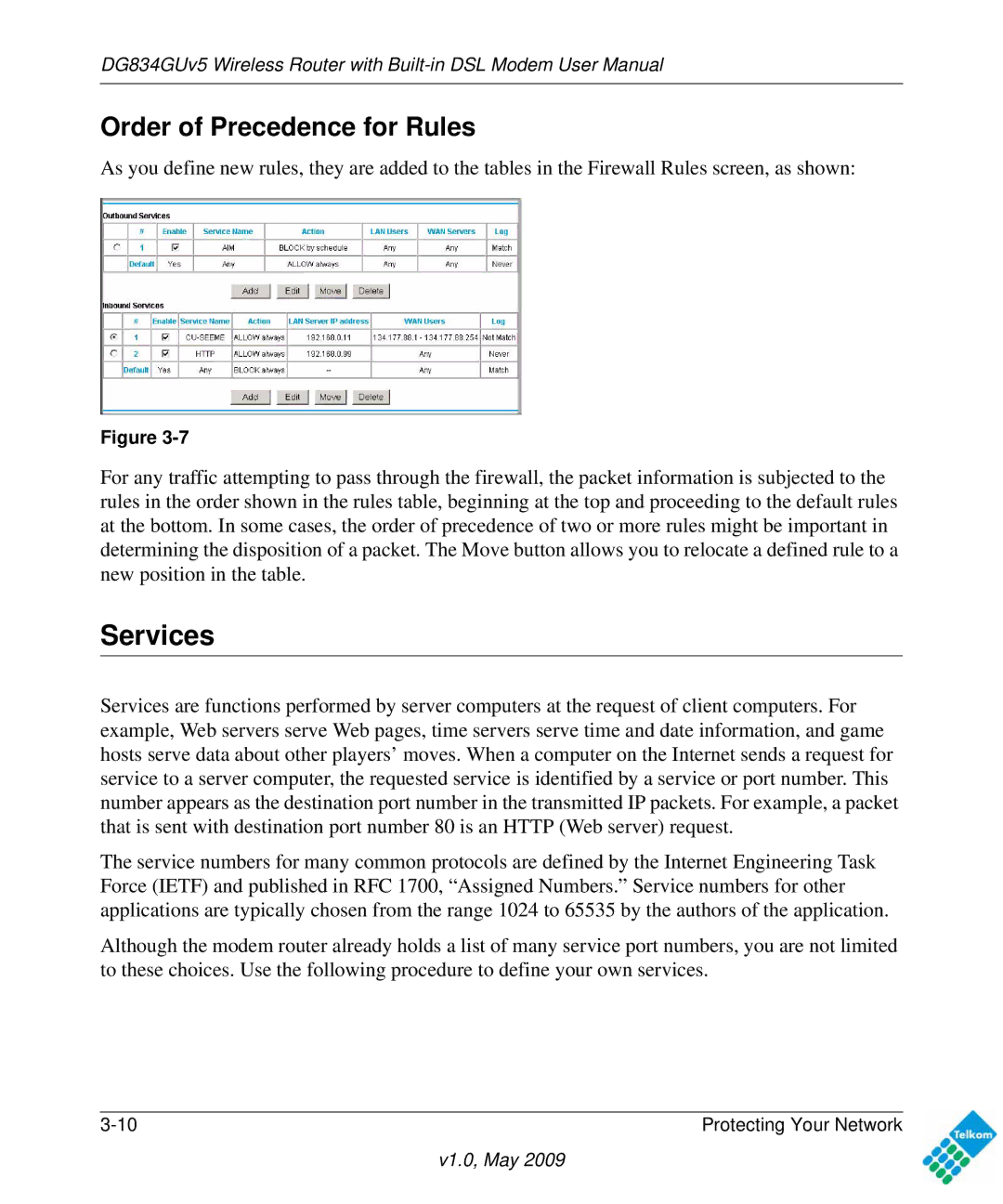NETGEAR, Inc
Statement of Conditions
FCC Statement
Trademarks
European Union Statement of Compliance
Bestätigung des Herstellers/Importeurs
1999/5/EG
Customer Support
Certificate of the Manufacturer/Importer
Voluntary Control Council for Interference Vcci Statement
V1.0, May
Contents
Chapter Protecting Your Network
Chapter Configuring Telkom VPN Lite
V1.0, May
About This Manual
Conventions, Formats, and Scope
Printing a page in the Html view
How to Use This Manual
How to Print this Manual
Printing a chapter
Printing the full manual
Xiv
Chapter Configuring Your Internet Connection
What You Need Before You Begin
Using the Installation CD to Set Up Your Router
Logging In to the Modem Router
Viewing or Manually Configuring Your ISP Settings
ISP does not require login
Basic Settings Fields Description
Settings Description
Get Automatically from ISP. Your ISP uses Dhcp to
Changing Your Adsl Settings
Want to use
How the Internet Connection Works
Chapter Configuring Your Wireless Network Security Settings
Planning Your Wireless Network
Wireless Placement and Range Guidelines
See Manually Configuring Your Wireless Network on
Wireless Security Options
Manually Configuring Your Wireless Network
V1.0, May
Wireless Settings
Ssid
Configuring Your Wireless Security
Wireless Security
Configuring WEP
Configuring WPA, WPA2, or WPA/WPA2
Using Push N Connect WPS to Configure Your Wireless Network
Using a WPS Button to Add a WPS Client
Using PIN Entry to Add a WPS Client
V1.0, May
V1.0, May
Advanced Wireless Settings for WPS and WDS
Hiding your wireless network name Ssid
Controlling Wireless Station Access
Turning off wireless connectivity completely
Restricting Access by MAC Address
V1.0, May
Chapter Protecting Your Network
Protecting Access to Your ADSL2+ Modem Wireless Router
Changing the Built-In Password
Configuring Basic Firewall Services
Changing the Administrator Login Time-out
Blocking Keywords, Sites, and Services
Blocking Keywords and Sites
Keyword Result
Firewall Rules
Inbound Rules Port Forwarding
Inbound Rule Example a Local Public Web Server
Inbound Rule Example Allowing Videoconferencing
Outbound Rule Example Blocking Instant Messenger
Outbound Rules Service Blocking
Considerations for Inbound Rules
V1.0, May
Services
Order of Precedence for Rules
Setting Times and Scheduling Firewall Services
V1.0, May
Scheduling Firewall Services
V1.0, May
Chapter Managing Your Network
Backing Up, Restoring, or Erasing Your Settings
Backing Up the Configuration to a File
Upgrading the Modem Router Firmware
Restoring the Configuration from a File
Erasing the Configuration
V1.0, May
Modem Router Status Fields
Network Management Information
Viewing Modem Router Status and Usage Statistics
DNS
Viewing Statistics
Viewing Connection Status
Router Statistics Fields
Viewing Attached Devices
Connection Status Fields for PPPoA
Viewing, Selecting, and Saving Logged Information
Security Log Entry Descriptions
Log Action Buttons
Selecting Which Information to Log
Saving Log Files on a Server
Dropped Packets
Activation and Administration
Log Message Examples
Enabling Security Event E-mail Notification
Send alerts and logs via email
Running Diagnostic Utilities and Rebooting the Modem Router
Configuring Remote Management
Enabling Remote Management
Select the Turn Remote Management On check box
Http//134.177.0.1238080
Chapter Advanced Configuration
Modifying Your WAN Setup
WAN Setup Settings
Setting Description
Setting Up a Default DMZ Server
Configuring Your LAN IP Settings
LAN IP Setup
LAN TCP/IP
Using the Modem Router as a Dhcp Server
Use Router as Dhcp Server
Defining Reserved IP Addresses
Click Edit or Delete
Configuring Dynamic DNS
Static Route Example
Using Static Routes
Select the Use a Dynamic DNS Service check box
Configuring Static Routes
Configuring Universal Plug and Play UPnP
V1.0, May
Configuring Wireless Bridging and Repeating WDS
Point-to-Point Bridge Configuration
Multi-Point Bridge Configuration
V1.0, May
Repeater with Wireless Client Association
V1.0, May
Configuring VPN Lite
Chapter Configuring Telkom VPN Lite
What is VPN Lite?
V1.0, May
V1.0, May
V1.0, May
Chapter Troubleshooting
Basic Functioning
Power LED Is Red
Troubleshooting Access to the Modem Router Main Menu
Power LED Is Not On
LAN or DSL or Internet Port LEDs Are Not On
Troubleshooting the ISP Connection
Adsl Link
DSL LED Is Off
DSL LED Is Solid Green
DSL LED Is Blinking
Obtaining a WAN IP Address
Click Connection Status
Troubleshooting PPPoE or PPPoA
Troubleshooting Internet Browsing
Troubleshooting a TCP/IP Network Using the Ping Utility
Testing the LAN Path to Your Router
Restoring the Default Configuration and Password
Testing the Path from Your Computer to a Remote Device
Problems with Date and Time
V1.0, May
Chapter Connecting a USB Drive to the Router
File Sharing Scenarios
Sharing Photos with Friends and Family
Sharing photos with friends and family
Storing Files in a Central Location for Playing or Printing
Storing files in a central location for printing
Understanding the USB Configuration Settings
Sharing Large Files with Colleagues
Network Access
FTP Access
Connecting a USB Drive to the DG834GUv5
Attached Device
USB Drive Requirements
Select the folder to share
Using the USB Drive Menu to Grant FTP Access Rights
Granting Users Access to the USB Drive
Granting an account access to the USB Device
Unmounting a USB Drive
\\10.0.0.2
Understanding the USB Drive Access Methods
Connecting to the USB Drive from a Local Web Browser
\\10.0.0.2\share\partition1
Locating the Internet Port IP Address
Connecting to the USB Drive from a Remote Computer
Accessing the Router’s USB Drive Remotely Using FTP
Configuring Windows 2000 and Windows XP
Connecting to the USB Drive From Your Home/Office Network
Configuring Windows 98SE and Windows ME
Enabling File and Printer Sharing
Accessing the USB Drive from My Network Places
Accessing the USB Drive from the Windows Start Menu
Accessing the USB Drive from Windows Explorer
\\ipaddress
Appendix a Technical Specifications
Network Protocol and Standards Compatibility
V1.0, May
AppendixB Related Documents
Document Link
V1.0, May

